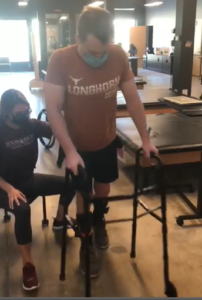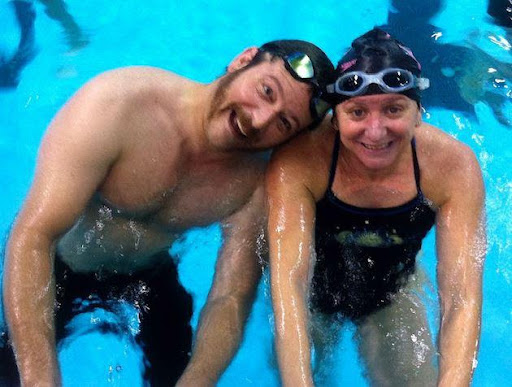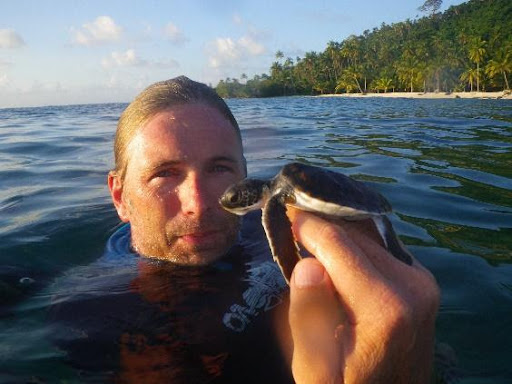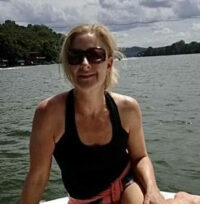Last April, Masters swimmer Philip Yeager set off alone on an evening hike along the Barton Creek Greenbelt in Austin, Texas, when pools closed during the pandemic.
The 24-year-old laboratory chemist said, “Maybe I was moving too fast when my foot slid on gravel. I fell about 25 feet, landing flat on my back near a creek bed.”
Yeager spent a week in intensive care at St. David’s South Austin Medical Center, and the next four months in hospitals and rehabilitation facilities. “My back may have hit a rock on the way down or perhaps I landed on a rock that fractured multiple vertebras,” he said after practice at the University of Texas Aquatics Center, pointing to a zipper-shaped scar running down his lower back.
 Today, Yeager swims four or five days a week with a foam pull buoy rigged with a strap to support his legs in the water. Many people who sustain such an injury never walk again. Last month, Yeager pulled himself up and walked with braces and a walker. (See Video of his Walk).
Today, Yeager swims four or five days a week with a foam pull buoy rigged with a strap to support his legs in the water. Many people who sustain such an injury never walk again. Last month, Yeager pulled himself up and walked with braces and a walker. (See Video of his Walk).
Another Masters teammate in his mid-60s was hit by a boat last spring during an open-water swim at Lake Travis during pool closures. After several surgeries and countless hours of rehabilitation to repair his hand—sliced by a propeller—he’s back in the pool, earning an All-American title this year as the fastest 500-yard-freestyler in the country for his age group.
My Unlikely Comeback
Twenty-five years after I stopped swimming competitively in high school, I unintentionally resumed the sport in my 40s, when I swam a few laps to cool off during an apocalyptic heatwave. Never—in a million years—did I imagine that I would squeeze into another skin-tight tech suit to race in a meet, but something about the water felt comforting, like I belonged to the tide.
For a decade, I have been swimming with the U.S. Masters Swimming team at Longhorn Aquatics Masters, located on the University of Texas campus. Fifty-year-old Olympic gold medalist Whitney Hedgepeth coaches the group, which includes about 160 swimmers ages 18 to 80. For more than 17 years, Hedgepeth has coached former college swimmers, beginners who nearly drowned, professional triathletes, and a growing number of middle-aged athletes saddled with worn-out joints, torn ligaments, and injuries sustained from pavement-pounding sports like tennis and running.
Our team is made up of high school teachers, commercial airline pilots, lobbyists, insurance and tech executives, bankers, stay-at-home moms and dads, Realtors and artists balancing work and family. We have so many physicians and attorneys that you can get medical and legal advice in any given lane.
Most mornings, Hedgepeth paces the pool deck with a Diet Coke before dawn, calling out intervals for sprints and mile-long sets that might challenge a runner. After practice, when we crawl out of the water with pounding hearts, flushed faces and burning muscles—her parting words of “good job” is just what we need to start the day.
Why We Swim
When pools shuttered due to Covid, teammates journaled about their withdrawal from our communal acre of water. Stacy Abrams, a swimmer in her mid-thirties who works as a career coach at the University of Texas wrote: “Drowning, but no water in sight.”

Colin Smiley and Katy Dooley Baxter, who completed the Triple Crown of Open Water Swimming, crossing the English Channel, the Catalina Channel, and completing the Manhattan Island Marathon swim.
Practice resumed about a year ago, swimming two-to-a-lane facing opposite directions in water radiating with so much chlorine that it ate the spandex out of our suits. For now, masks are voluntary. Gnarly, defiantly grown ZZ Top beards are gone, and practice is almost (yes, almost) back to normal as we chug up and down the lanes like freight cars wobbling into the station.
As we regain stamina, and speed, and reconnect with friends at the pool, the things we seek from the water have become crystal clear.
Journalist Bonnie Tsui believes that swimming helps us find a better, braver version of ourselves. In her book, “Why We Swim,” Tsui explores the seductive appeal of the water, which lures swimmers despite its dangers. In lyrical form, she writes, “To live deliberately as a swimmer means you are a seeker; a chaser of the ocean’s blue corduroy, a follower of river veins.”
Dr. Wallace J. Nichols, a marine biologist and author of the book “Blue Mind” uses neuroscience to explain why we are drawn to water. For years, he has gathered compelling personal stories from elite athletes, leading scientists, military veterans, and artists, to show how proximity to water can improve performance, increase calm, diminish anxiety, and increase professional success.
Nichols told me that merely being around water—swimming in a cold lake, kayaking through a marsh or listening to a thunderstorm on a screened porch, is a sensory enriching experience that makes us feel good.
He also believes that water is good medicine.
“Water positively impacts us before, during and after we swim. The anticipation and preparation, the dive in, stroking, gliding and floating, followed by the towel off and the special ‘stoked’ feeling we carry throughout the day. In good times, this is certainly therapeutic. It’s a chance to leave behind the anxiety and stress that can drag us down. In challenging times, it’s first-order lifesaving medicine,” he says.
Some of my teammates seek peace, and a sense of community in the water.

Laura Grim (far right in blue) with Beth Plevich and husband Max Stinchcombe at a Masters gathering. Photo: Jack Lee.
Laura Grim, a 48-year-old mother of four has swum with our Masters group for 25 years. Several years ago, her oldest daughter was diagnosed with a rare brain disease that diminished her mental abilities from that of a college girl on academic scholarship to a 22-year-old living with advanced dementia. “Elizabeth’s disease is terminal. The water lifts me and sometimes allows me to set aside my grief.”
“When I first got back in the pool, I had so much fear. I was afraid of my incompetence in the pool but more of the uncertainty in my life and how to manage my desperation to hold on to my daughter,” Grim said from the front porch of her home near the University. “I think there has been a re-set on life. My anguish for my child is mirrored in a new way as others come to the realization that no one knows what the future holds. The pool is that place where you can lower your guard—be angry, cry, or laugh like a child without judgement.”
Grim is also drawn to the sheer nakedness of the sport—where we are stripped down, exposing our vulnerabilities. “No one dresses up or brushes their hair. There is no pretense; we share lanes with people from totally different backgrounds and we support each other. You just come as you are and give yourself to the water,” she said.
Nichols agrees with the raw exposure that swimming brings. “In the water nobody knows what you drive. You are laid bare,” he said. “You don’t have to have fancy goggles. You just check your stuff at the door.”
Though Nichols says he would never want to portray “blue mind” as a silver bullet solution to serious health issues, he believes the emotional wellness benefits of being near, in, on and under water has the power to save us, just as it has done for millennia.
For me swimming is about numbers and self-preservation at age 56. Since my return to the water, I’ve shed ten pounds and my feet no longer make a crunching noise when I step out of bed for practice at 5 a.m. Most importantly, in a world where people are literally suffocating from a virus that is surging like a tidal wave, I know that I am doing something productive to keep my heart and lungs strong.
Anne Morrow Lindbergh, wife of aviator Charles Lindbergh and author of “Gift from the Sea,” viewed the water as an escape from the modern trappings of gadgets, and schedules that keep us frenzied. “Patience, patience, patience is what the sea teaches. Patience and faith,” she advised nearly 70 years ago. “One should lie empty, open, choiceless as a beach—waiting for a gift from the sea.”
For Philip Yeager, every lap is a gift that speeds up his recovery.
“Each week Coach Hedgepeth makes notes and pushes me to gain speed and endurance. A few months ago I swam a 50-yard freestyle in one minute. Today, I am doing a :43 in practice, along with butterfly,” he said. “There’s always a new goal and swimming keeps me moving forward.”
 ABOUT ANNE KEENE
ABOUT ANNE KEENE
Anne R. Keene is an Austin-based writer, Masters swimmer, essayist and author of The Cloudbuster Nine: The Untold Story of Ted Williams and the Baseball Team That Helped Win WWII. www.annerkeene.com
Founded in 1970, U.S. Masters Swimming provides training and competition to nearly 50,000 adults ages 18 to 100+. Swimmers can join USMS by taking advantage of its Year-Plus membership offering, which allows people to become a member through 2022 for just $99. To learn about Masters programs in your area, visit: https://www.usms.org/clubs.
Swimming is the fourth-most popular recreational sport in America, says the Centers for Disease Control and Prevention, after walking, running and cycling. USA Swimming, the national governing body for swimming, has 3,100 professional swimming clubs in the country, serving 400,000 members.



Sweet! We have linked to this story from within our collection at S6.CLOH.org. Well done writers. Keep spreading the good news.
Anne
you captured our team and spirit to a T! It always starts at the top and in this case with our incredible coach Whitney. No matter how you feel, happy, sad, tired or like me …usually grumpy …she brings out your best in every practice and you always end practice with a smile on your face even after Labor Day and cranking out 7000 yards!
from inspiring teammates like Phillip, or Don our 80 year old leader who is at practice 5 days a week or recent college grad swimmers that are are inspiring us with fast swims and underwaters I cannot even comprehend. What a team, what an atmosphere to train in everyday! I love it!
I have done a few drop ins to this team when in Austin on business. It is by far the one of the best masters teams around. Great organized practice, friendly members and a wonderful facility. Whitney will work you hard! I hope to meet Philip on my next visit. He sounds like a very positive inspiring person.
Nicely done Anne. Philip is such an inspiration for us all. I could have done without Colin’s picture, but I won’t let that take away from a great article.
Thanks it’s a churn for all of us, especially on Labor Day!
Something different in the ATX water supply